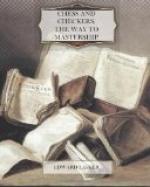32 31 30 +---------------------------------------+ | | | | | | o | | | 29 |---------------------------------------| 28 | * | | | | o | | | | |---------------------------------------| | | | | o | | o | | * | 21 |---------------------------------------| 20 | | | | | | | | | |---------------------------------------| | | | | * | | o | | o | 13 |---------------------------------------| 12 | | | * | | | | | | |---------------------------------------| | | * | | * | | | | * | 5 |---------------------------------------| 4 | | | | | | | | | +---------------------------------------+
3 2 1
Diagram 87.
White then sacrifices another man by 23-18 forcing Black to reply 14-23. Now White captures the three men on 23, 15 and 7 with his man on 26, and Black, before making his next move, must crown White’s man who has just reached the King’s row. He will naturally move his man 8, as otherwise White would capture him with the King on 3.
If a player overlooks the possibility of a capture his opponent has the right to remove the man who should have made the capture, from the board. This procedure is called “huffing” and does not constitute a play. Instead of huffing a player may ask the opponent to retract his move and to make the capture.
When neither player can force a win the game is considered a draw. When one side appears to be stronger and refuses to accept a draw offered the player of the weaker side can require the win to be demonstrated within 40 moves; otherwise the game is drawn.
II
ELEMENTARY TACTICS
The first thing a Checker player has to know is what superiority in material or position is required to force a win in the ending. The most elementary case is the one shown in Diagram 88, in which White wins by playing 32-27. With this move White takes the opposition or as most Checker players call it, White has the “move.” Whatever Black replies he is forced to the edge of the board and finally he is obliged to let White capture his King. Supposing Black plays (2) 26-22, in order to reach the double corner, where he would be safe as he could indefinitely move from 5 to 1 and from 1 to 5, then White continues with (2) ...,27-23, preventing (3) 22-18 which would gain the road to the double corner. After (3) 22-17, 23-l8; Black has to retreat to the edge by 17-13 or 17-21, and White, by playing 18-14, or 18-22 pins the black King so that he cannot move without being captured. If it had been Black’s move in the position of the diagram, he would have gained the opposition by 26-31 and White would have been compelled to retire to the double corner and to draw by 32-28, 28-32, etc.




